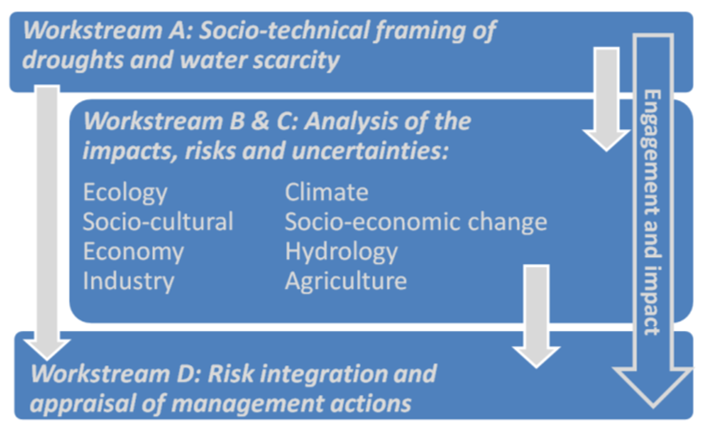The MaRIUS approach is defined by four work streams that interact to drive the required research to answer the project hypotheses.
- Work stream A (WS.A) - Controversies and governance of water scarcity
- Work Stream B (WS.B) - Probabilistic analysis of droughts and water scarcity
- Work Stream C (WS.C) - Impacts of water scarcity
- Work Stream D (WS.D) - Synthesis of risks and evaluation of management options

Work stream A (WS.A)
Controversies and governance of water scarcity – led by Sarah Whatmore (University of Oxford), this work stream will analyse how impacts and risks of droughts and water scarcity are currently understood and managed by key stakeholders, and how this is shaped by institutions, regulation and markets.
Work Stream B (WS.B)
Probabilistic analysis of droughts and water scarcity – Jim Freer (University of Bristol) steers this work stream which focuses upon analyses of water quantity and quality at catchment and national scales during droughts. It starts with the generation of an event set of hydrometeorological conditions which will be propagated through the MaRIUS suite of models in WS.B and WS.C for analysis of the impacts of water scarcity and computation of risk in WS.D.
Work Stream C (WS.C)
Impacts of water scarcity – Ian Holman (University of Cranfield) will guide the sub-team that will develop new methodology and models for analysing the impacts of water scarcity for the ecosystems, society and various economic activities including agriculture, industry and household consumers.
Work Stream D (WS.D)
Synthesis of risks and evaluation of management options – Jim Hall (University of Oxford) will lead the liaison with partners and stakeholders to innovate and investigate options for management of droughts. We will use the results from WS.B and WS.C to identify management options for reducing the risk of water and explore their governance and societal implications. An ‘impacts dashboard’ will allow the communication and exploration of different dimensions of impact and risk reduction options.
